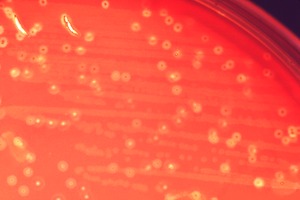Streptococcus anginosus group

Streptococcus anginosus group (SAG), also known as the Streptococcus milleri group, is a subgroup of the genus Streptococcus that consists of three distinct species: Streptococcus anginosus, Streptococcus constellatus, and Streptococcus intermedius. These bacteria are part of the normal flora of the human mouth, throat, digestive tract, and genitourinary tract, but they can become pathogenic under certain conditions, leading to a variety of infections.
Characteristics[edit]
The Streptococcus anginosus group is characterized by its ability to cause abscesses in various parts of the body, including the brain, liver, and lungs. These bacteria are facultatively anaerobic, gram-positive cocci that tend to form chains. They are different from other streptococci by their unique ability to ferment lactose and to produce a distinct type of hemolysis on blood agar plates, often described as "intermediate" between the clear beta-hemolysis and the green alpha-hemolysis.
Pathogenicity[edit]
While SAG species are commensal organisms in healthy individuals, they can become opportunistic pathogens, especially in people with compromised immune systems or underlying health conditions. The pathogenicity of these bacteria is attributed to their production of various enzymes and toxins that facilitate tissue invasion and immune system evasion. Infections caused by SAG can range from relatively minor, such as dental abscesses and tonsillitis, to severe, life-threatening conditions like bacteremia, meningitis, and deep-seated abscesses.
Diagnosis and Treatment[edit]
Diagnosis of SAG infections involves microbiological culture of specimens from the suspected infection site, followed by biochemical and molecular tests to identify the specific species involved. Treatment typically includes the administration of antibiotics, with the choice of antibiotic depending on the location and severity of the infection, as well as the susceptibility pattern of the isolate. Surgical intervention may be necessary to drain abscesses or manage complications.
Epidemiology[edit]
The epidemiology of SAG infections is not fully understood, as these bacteria are often overlooked or misidentified due to their close resemblance to other streptococci. However, they are increasingly recognized as important pathogens in both community and hospital settings, particularly in association with invasive infections.
Prevention[edit]
Prevention of SAG infections primarily involves maintaining good oral hygiene and promptly addressing any dental or periodontal issues. In hospital settings, strict adherence to infection control practices can help minimize the risk of nosocomial infections.
Streptococcus_anginosus_group[edit]
-
Streptococcus anginosus
Ad. Transform your life with W8MD's Budget GLP-1 injections from $75


W8MD offers a medical weight loss program to lose weight in Philadelphia. Our physician-supervised medical weight loss provides:
- Weight loss injections in NYC (generic and brand names):
- Zepbound / Mounjaro, Wegovy / Ozempic, Saxenda
- Most insurances accepted or discounted self-pay rates. We will obtain insurance prior authorizations if needed.
- Generic GLP1 weight loss injections from $75 for the starting dose.
- Also offer prescription weight loss medications including Phentermine, Qsymia, Diethylpropion, Contrave etc.
NYC weight loss doctor appointmentsNYC weight loss doctor appointments
Start your NYC weight loss journey today at our NYC medical weight loss and Philadelphia medical weight loss clinics.
- Call 718-946-5500 to lose weight in NYC or for medical weight loss in Philadelphia 215-676-2334.
- Tags:NYC medical weight loss, Philadelphia lose weight Zepbound NYC, Budget GLP1 weight loss injections, Wegovy Philadelphia, Wegovy NYC, Philadelphia medical weight loss, Brookly weight loss and Wegovy NYC
|
WikiMD's Wellness Encyclopedia |
| Let Food Be Thy Medicine Medicine Thy Food - Hippocrates |
Medical Disclaimer: WikiMD is not a substitute for professional medical advice. The information on WikiMD is provided as an information resource only, may be incorrect, outdated or misleading, and is not to be used or relied on for any diagnostic or treatment purposes. Please consult your health care provider before making any healthcare decisions or for guidance about a specific medical condition. WikiMD expressly disclaims responsibility, and shall have no liability, for any damages, loss, injury, or liability whatsoever suffered as a result of your reliance on the information contained in this site. By visiting this site you agree to the foregoing terms and conditions, which may from time to time be changed or supplemented by WikiMD. If you do not agree to the foregoing terms and conditions, you should not enter or use this site. See full disclaimer.
Credits:Most images are courtesy of Wikimedia commons, and templates, categories Wikipedia, licensed under CC BY SA or similar.
Translate this page: - East Asian
中文,
日本,
한국어,
South Asian
हिन्दी,
தமிழ்,
తెలుగు,
Urdu,
ಕನ್ನಡ,
Southeast Asian
Indonesian,
Vietnamese,
Thai,
မြန်မာဘာသာ,
বাংলা
European
español,
Deutsch,
français,
Greek,
português do Brasil,
polski,
română,
русский,
Nederlands,
norsk,
svenska,
suomi,
Italian
Middle Eastern & African
عربى,
Turkish,
Persian,
Hebrew,
Afrikaans,
isiZulu,
Kiswahili,
Other
Bulgarian,
Hungarian,
Czech,
Swedish,
മലയാളം,
मराठी,
ਪੰਜਾਬੀ,
ગુજરાતી,
Portuguese,
Ukrainian

